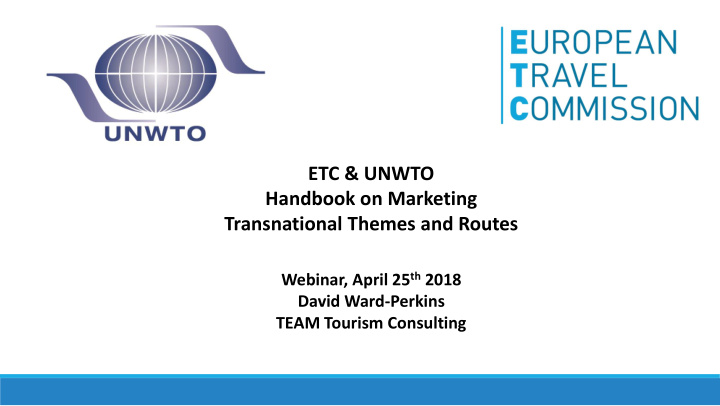



ETC & UNWTO Handbook on Marketing Transnational Themes and Routes Webinar, April 25 th 2018 David Ward-Perkins TEAM Tourism Consulting
The Handbook • A Global Overview of transnational themed tourism and routes • A European Mapping • A Practical Guide to development and marketing • 80 cases , including 18 longer case studies Authors: David Ward-Perkins, Issa Torres, Jennifer Houiellebecq, Jackie Ellis
Part 1: Themes and routes
The context: some observations Tourism is not about assets, but about experiences. We are seeing the emergence of routes as a tourism phenomenon, and many of the more significant routes operate internationally. What are the implications for how we plan tourism?
A look to the future Transnational tourism will continue to grow It will be structured according to themes: experiences, emotions, values. It will change the way we plan tourism. This is just the beginning.
This webinar We need to understand: • Why this is happening • Where it is going • What to do about it.
Where is tourism coming from, and where is it going? I950s to ‘70s: 21st century: ‘80s to ‘000s: ‘Get -away ’ Experience Destination focused focused focused
Destination-focused tourism Concentration of tourists around iconic attractions Cities with multiple assets Providing a strong cultural offer Driven by powerful DMOs, backed by a structured local tourism industry
Driven by: low cost, multi-destination travel
Driven by: short break tourism
Driven by … • Competition between destinations • Protection of existing markets; emergence of new markets • Increasing professionalisation of tourism providers
The weaknesses in this model Overcrowding around key sites Concentration on cities; tends to neglect rural areas Pressure on transport hubs Low incentive for repeat visits Uncertain or negative impact on local businesses and residents … Therefore increasingly seen as unsustainable
An alternative: theme-based tourism More varied and flexible, in terms of location Could be urban, coastal, rural or other More likely to generate repeats Higher engagement with local businesses and communities
Some implications • Bottom up rather than top-down. Encourages grass roots engagement • A theme can differentiate: help the visitor see and understand • A theme is a story, and the story can have many chapters and sub- plots.
New models of tourism, and how to manage them
The new role of the DMO • Providing infrastructure • Making the experiences accessible and understandable • Encouraging networks • Becoming a listening organisation • Providing a structure
Linking up the assets (1)
The Alsace Wine Trail
End of Part 1 QUESTIONS?
Part 2: Going transnational
Linking up the assets … internationally Example of a route for bikers
Addressing niche markets Black Paris Tours A richly unique cultural experience, providing travelers with insight and little known facts about the wealth of Black history in Paris. The hang outs, haunts and places made famous by African American musicians, soldiers, writers, artists, historians, celebrities, and political exiles.
… and massive markets One third of Europe’s adult population consider themselves to be ‘ hikers ’. In Germany, it is over half that claim they have taken a significant walk for leisure in the previous week.
… through routes and through events Festival of African masks, Burkina Faso Countries where masks are used traditionally
Appealing to romantics: The magic of travel and distance Trans-Siberian railway
The importance of scale Qhapaq Ñan The Silk Road
As much the journey as the destination
Networks of routes in Europe
Opportunities (example) Opportunities for transnational theme-based tourism in the western and central Mediterranean include the following: Food and drink tourism, with vineyards, olive trees, and the common, shared landscape of the Mediterranean basin. Maritime life, including nautical routes. Transnational historic heritage, including both Christian and Muslim traditions. Ecosystems and landscapes, creating opportunities for ecotourism and outdoor activities. Pilgrimage routes and spiritual travel. The arts, including painting, architecture, sculpture, literature, and music.
Key criteria What makes a transnational initiative work? • The strength of the story, and how well it is heard • The engagement and the partnership • Time and persistence
Journey and imagination: the Alaska Highway
Story and spirituality: Turas Columbanus
Journey and locality: St Olav Ways
Journey and activity: the Danube cycle path Highlight: • 1,800 miles • 10 countries
Journey and culture The Roman Emperors Route and The Danube Wine Route Highlight: Spreads through four countries of the Middle and Lower Danube Region – Croatia, Serbia, Bulgaria and Romania Encompassing 20 archaeological sites and 12 wine regions
Key words to retain • Experiences • Stakeholders, ambassadors • Partnership, coordination
Implementation
For further information: www.etc-corporate.org unwto.org DavidWardPerkins@team-tourism.com
End of Part 2 Thank you for your interest! QUESTIONS?
ETC & UNWTO Handbook on Marketing Transnational Tourism Themes and Routes Linz Durham Cork Linz Avignon Trento Roskilde With the support of Handbook on Marketing Transnational Tourism Themes and Routes
Recommend
More recommend